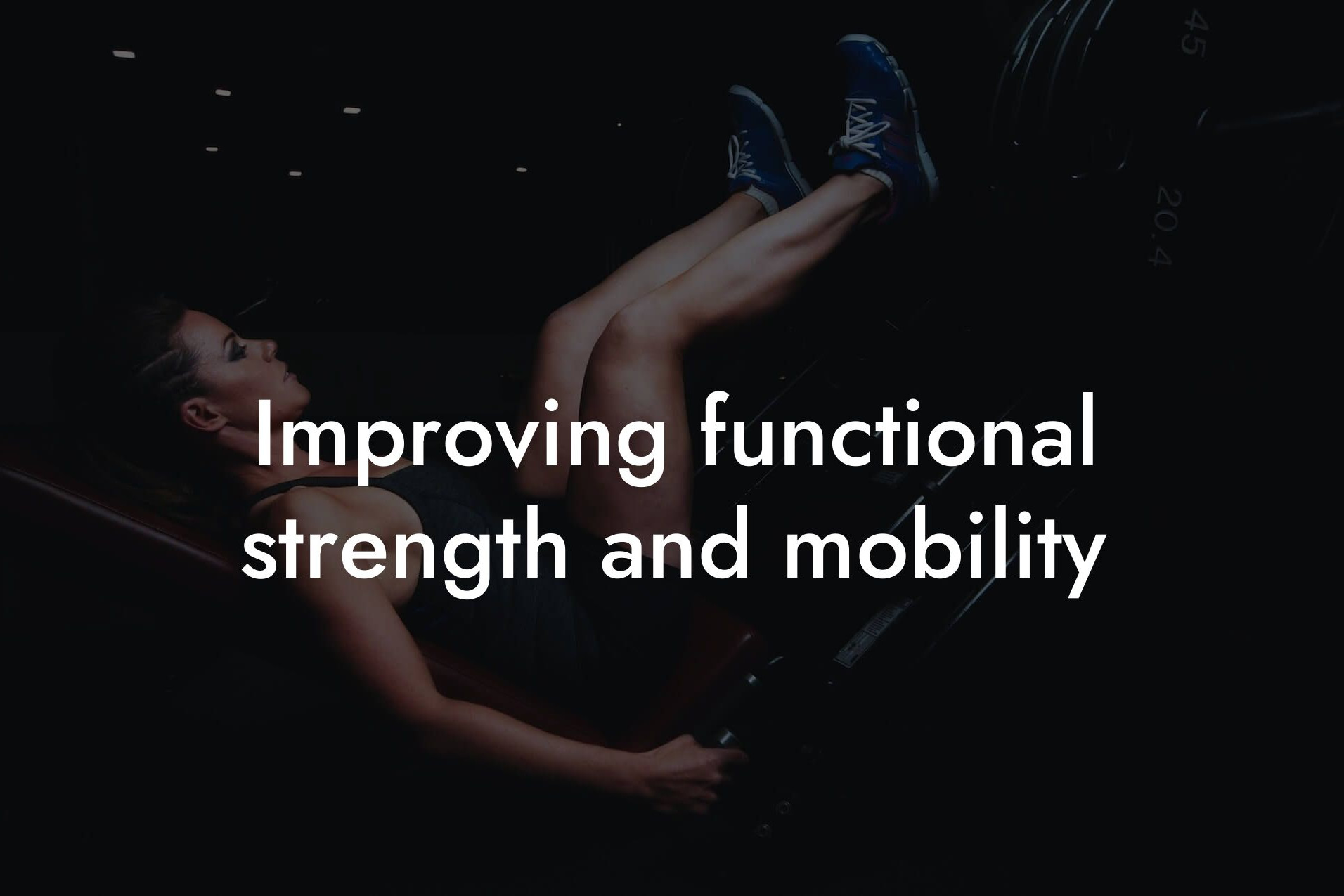As a high-earning professional, you understand the importance of maintaining a healthy and fit physique. Not only does it boost your confidence, but it also enhances your overall well-being and energy levels. However, with a busy schedule, it can be challenging to prioritize exercise and recovery. This is where functional training comes in – a type of exercise that focuses on improving muscle recovery, flexibility, and overall physical performance. In this article, we'll delve into the world of functional training and explore how it can help you maintain muscle recovery and take your physical appearance to the next level.
Table of Contents
- What is Functional Training?
- Benefits of Functional Training for Muscle Recovery
- Types of Functional Training Exercises
- How to Incorporate Functional Training into Your Workout Routine
- Common Mistakes to Avoid in Functional Training
- The Role of DEXA Scans in Functional Training
- Final Tips and Recommendations
- Frequently Asked Questions
What is Functional Training?
Functional training is a type of exercise that focuses on improving coordination, balance, and movement patterns. It involves performing exercises that mimic real-life movements, such as squatting, lifting, and twisting. This approach is different from traditional weightlifting, which often isolates specific muscle groups. Functional training, on the other hand, engages multiple muscle groups simultaneously, improving overall muscle function and recovery.
Benefits of Functional Training for Muscle Recovery
Functional training offers several benefits for muscle recovery, including:
Improved flexibility and range of motion: Functional exercises help increase flexibility and range of motion, reducing the risk of injury and improving overall mobility.
Enhanced muscle activation: Functional training engages multiple muscle groups, ensuring that all muscles are activated and working together efficiently.
Better joint stability: Functional exercises help improve joint stability, reducing the risk of injury and improving overall joint health.
Increased muscle endurance: Functional training improves muscle endurance, allowing you to perform daily tasks with more energy and efficiency.
Types of Functional Training Exercises
There are various types of functional training exercises that can help improve muscle recovery. Some of the most effective exercises include:
Squats: Squats are an excellent exercise for improving leg strength, flexibility, and balance.
Lunges: Lunges target the legs, glutes, and core, improving balance, flexibility, and overall lower body strength.
Step-ups: Step-ups are a great exercise for improving leg strength, balance, and coordination.
Deadlifts: Deadlifts engage multiple muscle groups, including the legs, glutes, and back, improving overall muscle function and recovery.
Planks: Planks are an isometric exercise that targets the core, improving core strength, stability, and overall muscle endurance.
How to Incorporate Functional Training into Your Workout Routine
Incorporating functional training into your workout routine can be easy and convenient. Here are some tips to get you started:
Start with compound exercises: Focus on exercises that engage multiple muscle groups, such as squats, lunges, and deadlifts.
Incorporate plyometric exercises: Plyometric exercises, such as jump squats and box jumps, can help improve power and explosiveness.
Use functional equipment: Use equipment such as kettlebells, medicine balls, and resistance bands to add variety to your workouts.
Focus on movement patterns: Focus on exercises that mimic real-life movements, such as twisting, lifting, and bending.
Common Mistakes to Avoid in Functional Training
While functional training can be highly effective, there are some common mistakes to avoid:
Overdoing it: Avoid overdoing it, especially if you're new to functional training. Start with lower intensities and gradually increase as you build strength and endurance.
Poor form: Poor form can lead to injury and ineffective workouts. Focus on proper form and technique, and seek guidance from a qualified trainer if needed.
Not warming up: Always warm up before starting your workout, and cool down afterwards to prevent injury and improve recovery.
The Role of DEXA Scans in Functional Training
At Tano Performance Group, we understand the importance of tracking progress and monitoring body composition. This is where DEXA scans come in – a non-invasive, pain-free test that provides a comprehensive body assessment. DEXA scans can help you:
Track body fat percentage: DEXA scans provide an accurate measurement of body fat percentage, helping you monitor progress and adjust your workout routine accordingly.
Monitor bone density: DEXA scans can help monitor bone density, reducing the risk of osteoporosis and fractures.
Identify muscle imbalances: DEXA scans can help identify muscle imbalances, allowing you to target specific areas and improve overall muscle function.
Maintaining muscle recovery is crucial for overall physical performance and well-being. Functional training is an effective way to improve muscle recovery, flexibility, and overall physical function. By incorporating functional training into your workout routine, you can improve muscle endurance, reduce the risk of injury, and enhance overall physical performance. Remember to start slowly, focus on proper form and technique, and track progress with DEXA scans. With consistent effort and dedication, you can achieve your fitness goals and take your physical appearance to the next level.
Final Tips and Recommendations
Here are some final tips and recommendations to help you get the most out of functional training:
Seek guidance from a qualified trainer: If you're new to functional training, seek guidance from a qualified trainer to ensure proper form and technique.
Listen to your body: Listen to your body and take rest days as needed. Functional training can be intense, so it's essential to allow your body time to recover.
Stay hydrated and fuel your body: Stay hydrated and fuel your body with a balanced diet to support muscle recovery and growth.
Track progress and adjust accordingly: Track progress with DEXA scans and adjust your workout routine accordingly. This will help you stay motivated and ensure you're achieving your fitness goals.
Frequently Asked Questions
What is functional training and how does it relate to muscle recovery?
Functional training is a type of exercise that focuses on improving coordination, balance, and overall functional movement patterns. It involves performing exercises that mimic daily activities and movements, such as squatting, lunging, and reaching. This type of training is essential for muscle recovery as it helps to strengthen the muscles and improve joint mobility, reducing the risk of injury and improving overall physical function.
Why is muscle recovery important for high-earning professionals?
Muscle recovery is crucial for high-earning professionals as it allows them to maintain their physical performance and overall health, despite their busy schedules. When muscles are not properly recovered, it can lead to fatigue, decreased productivity, and a higher risk of injury. By prioritizing muscle recovery, professionals can maintain their physical appearance, improve their energy levels, and stay focused and motivated throughout the day.
How does functional training improve muscle recovery?
Functional training improves muscle recovery by strengthening the muscles, improving joint mobility, and enhancing overall physical function. This type of training also helps to improve blood flow and reduce inflammation, which are both essential for muscle recovery. Additionally, functional training can help to improve sleep quality, reduce stress, and boost mood, all of which are critical for muscle recovery.
What are some common mistakes people make when it comes to muscle recovery?
One of the most common mistakes people make when it comes to muscle recovery is not allowing themselves sufficient time to rest and recover. This can lead to overtraining, fatigue, and a higher risk of injury. Another common mistake is not incorporating stretching and foam rolling into their routine, which can help to improve flexibility and reduce muscle soreness. Finally, not fueling their bodies with the right nutrients can also hinder muscle recovery.
How often should I be doing functional training to aid in muscle recovery?
The frequency of functional training will depend on your individual goals and current fitness level. However, as a general rule, it's recommended to incorporate functional training into your routine 2-3 times per week, with at least one day of rest in between. This will allow your muscles to recover and rebuild, while also improving your overall physical function.
What are some examples of functional training exercises?
Examples of functional training exercises include squats, lunges, step-ups, and deadlifts. These exercises work multiple muscle groups at once and help to improve coordination, balance, and overall physical function. Other examples include exercises that target the core, such as planks and Russian twists, as well as exercises that target the upper body, such as push-ups and rows.
How does functional training improve bone density?
Functional training improves bone density by strengthening the muscles and improving joint mobility. This type of training also helps to stimulate osteogenesis, which is the process by which new bone tissue is formed. Additionally, functional training can help to improve balance and coordination, reducing the risk of falls and fractures.
Can functional training help with weight loss?
Yes, functional training can help with weight loss. This type of training helps to build muscle mass, which can increase metabolism and burn more calories at rest. Additionally, functional training can help to improve insulin sensitivity, reducing the risk of chronic diseases such as type 2 diabetes.
How does functional training improve physique?
Functional training improves physique by building lean muscle mass, improving body composition, and enhancing overall physical function. This type of training can help to create a more toned and athletic appearance, while also improving posture and reducing the risk of injury.
What are some common myths about functional training?
One common myth about functional training is that it's only for athletes or individuals who are already in good physical shape. However, functional training is beneficial for individuals of all fitness levels and can be modified to suit individual needs and goals. Another myth is that functional training is only about improving physical function, when in fact it can also improve mental health and overall well-being.
How does functional training improve mental health?
Functional training improves mental health by reducing stress and anxiety, improving mood, and enhancing overall cognitive function. This type of training can also help to improve sleep quality, which is essential for overall mental health and well-being.
Can functional training be done at home or do I need to go to a gym?
Functional training can be done at home or in a gym, depending on your personal preference and goals. There are many bodyweight exercises that can be done at home, such as squats, lunges, and push-ups. However, if you're looking to incorporate more advanced exercises or equipment into your routine, a gym may be a better option.
How long does it take to see results from functional training?
The amount of time it takes to see results from functional training will depend on your individual goals and current fitness level. However, with consistent training and proper nutrition, you can start to see improvements in physical function and overall health within 6-8 weeks.
What are some common injuries associated with functional training?
Common injuries associated with functional training include strains, sprains, and overuse injuries. However, these can be prevented by proper warm-up and cool-down, listening to your body, and incorporating rest and recovery into your routine.
How does functional training improve body fat percentage?
Functional training improves body fat percentage by building lean muscle mass, improving insulin sensitivity, and enhancing overall metabolic function. This type of training can also help to increase excess post-exercise oxygen consumption (EPOC), which can help to burn more calories at rest.
Can functional training be modified for beginners?
Yes, functional training can be modified for beginners. This can include reducing the intensity and volume of exercises, incorporating more bodyweight exercises, and focusing on proper form and technique. It's also important to listen to your body and take regular breaks to avoid fatigue and injury.
How does functional training improve overall health?
Functional training improves overall health by reducing the risk of chronic diseases, improving cardiovascular health, and enhancing overall physical function. This type of training can also help to improve mental health, reduce stress and anxiety, and enhance overall well-being.
What are some common benefits of functional training?
Common benefits of functional training include improved physical function, enhanced athletic performance, and reduced risk of injury. This type of training can also help to improve body composition, reduce body fat percentage, and enhance overall mental health and well-being.
How does functional training improve athletic performance?
Functional training improves athletic performance by enhancing power, speed, and agility. This type of training can also help to improve endurance, reduce fatigue, and enhance overall physical function. Additionally, functional training can help to improve mental toughness and focus, which are essential for athletic performance.
Can functional training be incorporated into a busy schedule?
Yes, functional training can be incorporated into a busy schedule. This can include incorporating short, high-intensity workouts into your daily routine, or finding a workout buddy to help keep you motivated and accountable. It's also important to prioritize rest and recovery, and to listen to your body and take regular breaks to avoid fatigue and injury.
Here are some related articles you might love...
- Nutrition strategies for functional training enthusiasts
- Improving functional strength and mobility
- Strength training tips specific to functional exercises
- The importance of bone density in functional fitness
- Preventing injuries in functional training: A comprehensive guide
- Balancing strength, speed, and flexibility in functional training
- How DEXA scans can benefit functional training athletes
- The role of body composition in functional training performance
- Reducing body fat for better functional training results
Zak Faulkner
Zak Faulkner is a leading authority in the realm of physical health and body composition analysis, with over 15 years of experience helping professionals optimise their fitness and well-being. As one the experts behind Tano Performance Group, Zak has dedicated his career to providing in-depth, science-backed insights that empower clients to elevate their physical performance and overall health.
With extensive knowledge of DEXA technology, Zak specializes in delivering comprehensive body assessments that offer precise data on body fat, muscle mass, bone density, and overall physique. His expertise enables individuals to make informed decisions and achieve their fitness goals with accuracy and confidence. Zak’s approach is rooted in a deep understanding of human physiology, combined with a passion for helping clients unlock their full potential through personalised strategies.
Over the years, Zak has earned a reputation for his commitment to excellence, precision, and client-focused service. His guidance is trusted by top professionals who demand the best when it comes to their health. Whether advising on fitness programs, nutritional strategies, or long-term wellness plans, Zak Faulkner’s insights are a valuable resource for anyone serious about taking their health and fitness to the next level.
At Tano Performance Group, Zak continues to lead our Content Team revolutionising how professionals approach their physical health, offering unparalleled expertise that drives real results.




